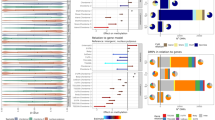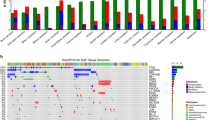Abstract
Chordoma is a rare malignant tumor with notochordal differentiation, usually affecting the axial skeleton of young patients. We report a case of a high-grade epithelioid tumor involving the synovium and soft tissues of the knee in a 74-year-old male patient. The preliminary biopsy was inconclusive, but a diagnosis of metastatic clear-cell carcinoma of unknown origin was suggested. However, imaging studies did not reveal any primary lesions. The resection specimen consisted of nests and sheets of oval to polygonal cells with discernible cell borders, clear or lightly amphophilic cytoplasm, and round to oval nuclei with occasional well-visible eosinophilic nucleoli. Rare atypical mitoses, necrotic areas, and bizarre nuclei were noted. The biopsy and resection specimens underwent a wide molecular genetic analysis which included methylation profiling. The DKFZ sarcoma classifier assigned the methylation class chordoma (dedifferentiated) with a calibrated score of 0.96, and additionally, a loss of SMARCB1 locus was noted in the copy number variation plot. To verify these findings, T-brachyury and SMARCB1 immunostaining was performed afterward, showing diffuse nuclear positivity and complete loss in the tumor cells, respectively. To assess the prevalence of T-brachyury immunopositivity among SWI/SNF-deficient tumors and to evaluate its specificity for poorly differentiated chordoma, we analyzed a series of 23 SMARCB1- or SMARCA4-deficient tumors, all of which were negative. After incorporating all the available data, including the absence of any morphological features of conventional chordoma, the case was diagnosed as poorly differentiated chordoma. As illustrated herein, the utilization of methylation profiling in the diagnostic process of some carefully selected unclassifiable soft tissue neoplasms may lead to an increased detection rate of such extremely rare soft tissue tumors and enable their better characterization.



Similar content being viewed by others
Data Availability
Data supporting the findings of this study are available within the article. The complete datasets generated during and/or analyzed during the current study are available from the corresponding author on reasonable request.
Code availability
Not applicable.
References
Vujovic S, Henderson S, Presneau N et al (2006) Brachyury, a crucial regulator of notochordal development, is a novel biomarker for chordomas. J Pathol 209(2):157–165
Tirabosco R, Mangham DC, Rosenberg AE et al (2008) Brachyury expression in extra-axial skeletal and soft tissue chordomas: a marker that distinguishes chordoma from mixed tumor/myoepithelioma/parachordoma in soft tissue. Am J Surg Pathol 32(4):572–580
Salisbury JR, Isaacson PG (1985) Demonstration of cytokeratins and an epithelial membrane antigen in chordomas and human fetal notochord. Am J Surg Pathol 9(11):791–797
Scolyer RA, Bonar SF, Palmer AA et al (2004) Parachordoma is not distinguishable from axial chordoma using immunohistochemistry. Pathol Int 54(5):364–370
WHO Classification of Tumours Editorial Board. Soft tissue and bone tumours [Internet]. Lyon (France): International Agency for Research on Cancer; 2020 [cited 2023 May 9]. (WHO classification of tumours series, 5th ed.; vol. 3). Available from: https://tumourclassification.iarc.who.int/chapters/33
Lv GH, Zou MX, Liu FS et al (2019) Clinicopathological and prognostic characteristics in extra-axial chordomas: an integrative analysis of 86 cases and comparison with axial chordomas. Neurosurgery 85(3):E527–E542
Neumann J, Gersing AS, Barth TF, Boxberg M, Woertler K (2019) Intra-articular extra-axial chordoma of the wrist: a case report with review of the current literature. Skelet Radiol 48(12):2015–2020
Ueda T, Kubota K, Shiroma N et al (2020) Extra-axial chordoma of the gingiva. Auris Nasus Larynx 47(2):299–304
Balogh P, O'Donnell P, Lindsay D, Amary MF, Flanagan AM, Tirabosco R (2020) Extra-axial skeletal poorly differentiated chordoma: a case report. Histopathology 76(6):924–927
Ball S, Dash A, Igid HP, Thein KZ, Sharma U, Tijani L (2020) Primary extra-axial chordoma masquerading as lung cancer: case report and review of the literature. Clin Lung Cancer 21(6):e560–e563
Lee S, Halpern JL, Liang J (2021) Pediatric extra-axial chordoma: case report and literature review. Pediatr Dev Pathol 24(6):585–591
Tehrani SG, Kaltoft NS, Melchior LC, Loya AC (2021) Extra-axial chordoma of the thumb: report of a rare case with clinicopathologic and molecular analysis. Pathol Res Pract 225:153564
Kurzawa P, Fundowicz M, Dopierała M, Larque AB, Nielsen GP (2018) Primary extra-axial, para-articular chordoma of the knee. A case report and the review of literature. Histopathology 72(5):883–885
Righi A, Sbaraglia M, Gambarotti M et al (2018) Extra-axial chordoma: a clinicopathologic analysis of six cases. Virchows Arch 472(6):1015–1020
Shih AR, Cote GM, Chebib I et al (2018) Clinicopathologic characteristics of poorly differentiated chordoma. Mod Pathol 31(8):1237–1245
Koelsche C, Schrimpf D, Stichel D et al (2021) Sarcoma classification by DNA methylation profiling. Nat Commun 12:498
Wen X, Cimera R, Aryeequaye R, Abhinta M, Athanasian E, Healey J, Fabbri N, Boland P, Zhang Y, Hameed M (2021) Recurrent loss of chromosome 22 and SMARCB1 deletion in extra-axial chordoma: a clinicopathological and molecular analysis. Genes Chromosom Cancer 60(12):796–807
Rekhi B, Michal M, Ergen FB et al (2021) Poorly differentiated chordoma showing loss of SMARCB1/INI1: clinicopathological and radiological spectrum of nine cases, including uncommon features of a relatively under-recognized entity. Ann Diagn Pathol 55:151809
Capper D, Jones DTW, Sill M et al (2018) DNA methylation-based classification of central nervous system tumours. Nature 555:469–474
Kohashi K, Yamamoto H, Yamada Y, Kinoshita I, Oda Y (2021) Brachyury expression in intracranial SMARCB1-deficient tumors: important points for distinguishing poorly differentiated chordoma from atypical teratoid/rhabdoid tumor. Hum Pathol 112:1–8
Kinoshita I, Kohashi K, Yamamoto H et al (2021) Myxoepithelioid tumour with chordoid features: a clinicopathological, immunohistochemical and genetic study of 14 cases of SMARCB1/INI1-deficient soft-tissue neoplasm. Histopathology 79(4):629–641
Funding
This study was supported by the study grant SVV 260652 from the Ministry of Education, Czech Republic (Natálie Klubíčková); by the Cooperatio program, research area SURG (Natálie Klubíčková, Michael Michal); and by the Cooperatio Program, research area Medical Diagnostics and Basic Medical Sciences (Jindra Brtková).
Author information
Authors and Affiliations
Contributions
All authors contributed to the study’s conception and design. Material preparation, data collection, and analysis were performed by Natálie Klubíčková, Marián Švajdler, and Jiří Soukup. The first draft of the manuscript was written by Natálie Klubíčková, and all authors commented on previous versions of the manuscript. All authors read and approved the final manuscript.
Corresponding author
Ethics declarations
Ethics approval
The study was approved by the institutional review board of the Faculty of Medicine in Pilsen, Charles University. The procedures used in this study adhere to the tenets of the Declaration of Helsinki.
Consent to participate
No patient consent was required for this study.
Conflict of interest
The authors declare no competing interests.
Additional information
Publisher’s note
Springer Nature remains neutral with regard to jurisdictional claims in published maps and institutional affiliations.
Supplementary information
ESM 1
(DOCX 15 kb)
Rights and permissions
Springer Nature or its licensor (e.g. a society or other partner) holds exclusive rights to this article under a publishing agreement with the author(s) or other rightsholder(s); author self-archiving of the accepted manuscript version of this article is solely governed by the terms of such publishing agreement and applicable law.
About this article
Cite this article
Klubíčková, N., Michal, M., Kinkor, Z. et al. Poorly differentiated extra-axial extraskeletal chordoma diagnosed by methylation profiling: case report and analysis of brachyury expression in SWI/SNF-deficient tumors. Virchows Arch 484, 621–627 (2024). https://doi.org/10.1007/s00428-023-03620-8
Received:
Revised:
Accepted:
Published:
Issue Date:
DOI: https://doi.org/10.1007/s00428-023-03620-8




